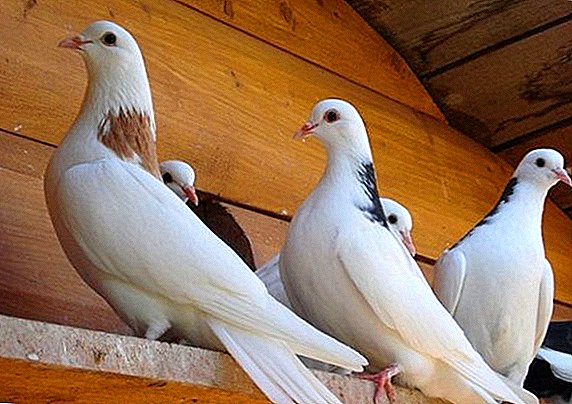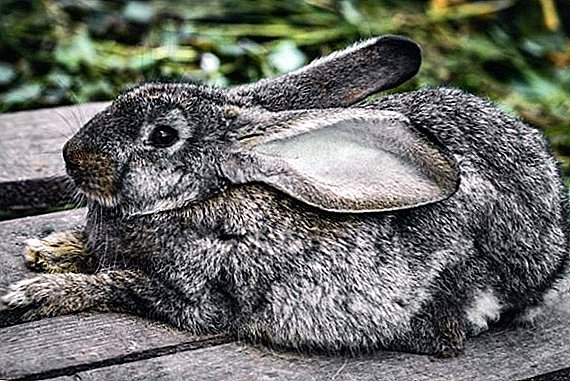 Breeders always doubt whether to leave on a tribe of rabbits that rush at the owner, bite, destroy the cage, make snarling sounds and loudly bang their paws. According to experts, this atypical behavior is due to the conditions of maintenance and treatment of the owner to his ward. Caress and adjustment of living conditions can be corrected. The reasons for the aggression of females and the methods of their taming will be discussed further.
Breeders always doubt whether to leave on a tribe of rabbits that rush at the owner, bite, destroy the cage, make snarling sounds and loudly bang their paws. According to experts, this atypical behavior is due to the conditions of maintenance and treatment of the owner to his ward. Caress and adjustment of living conditions can be corrected. The reasons for the aggression of females and the methods of their taming will be discussed further.
Why does the bunny behave aggressively
Any behavior of rabbits that creates discomfort and problems for people can be explained. Do not forget that these cute mammals have a well-developed nervous system, in which work is also possible failures. In addition, the eared pets are experiencing silence in silence.  That is why experts advise the breeders to fully meet all the needs of their wards. Otherwise, prolonged stress will lead to a decrease in the immune functions of their organisms, diseases and death.
That is why experts advise the breeders to fully meet all the needs of their wards. Otherwise, prolonged stress will lead to a decrease in the immune functions of their organisms, diseases and death.
Did you know? There are breeds of decorative rabbits, which are distinguished by unprecedented aggression from birth. One of these is the color pygmy rabbit. These eared representatives of the fauna have a peculiar character and bold character.If rabbits behave aggressively, then the owner is doing something wrong. Let's look at the main causes of the atypical behavior of these animals and methods of calming them down.
Fear
Fear and distrust leads the animal when it does not make contact with the person. Rabbits are very shy and may even die of fear. Each time the rabbit bass opens the rabbit's door, eared creatures perceive this invasion as a threat to their lives and are desperately trying to protect themselves before dying.  In this case, you need to understand that rabbit aggression occurs automatically. In addition, it can be caused not only by a person, but by any threatening subject. For example, a brush, a bucket, a scoop, a vacuum cleaner. To understand what or whom your pet is afraid of, it is important to watch him.
In this case, you need to understand that rabbit aggression occurs automatically. In addition, it can be caused not only by a person, but by any threatening subject. For example, a brush, a bucket, a scoop, a vacuum cleaner. To understand what or whom your pet is afraid of, it is important to watch him.
In such a situation is extremely undesirable:
- sneak up to the cell unnoticed;
- open the door abruptly;
- disturb eared during sleep or eating;
- grab it from above;
- purposely provoke aggression, touching the pet;
- lean over the cage.
Did you know? Due to the fact that the eyes of the rabbit are planted on the sides, he sees almost 360 degrees. Such a vision allows you to notice the enemy from afar, even if he sneaks up behind you. But what is in front of his own nose, the rabbit will not see. To better view the subject, he turns his head to the side.Try to stroke the aggressor more often, give him treats from his hands, talk to him. Act slowly, do not demand too much from him.
Territory protection
Often atypical behavior in rabbits appears with every attempt by the owner to get out of the cage, change litter, pour water, or get a feeder. According to experts, this is due to the violation of the territorial boundaries of the pet.  The fact is that eared people consider their home a fortress, where nothing threatens them, therefore they zealously defend their monastery, because it is there that they feel that they are full owners.
The fact is that eared people consider their home a fortress, where nothing threatens them, therefore they zealously defend their monastery, because it is there that they feel that they are full owners.
Learn how to make a cage for rabbits, a shed, a barn, a cottage, a water bowl, a feeding trough and a sennik.
Angry at the ward for the fact that he selflessly attacks your hand, not worth it. To wean him from this habit, experienced breeders advise:
- at the time of harvesting and changing feed in the feeders to produce a rabbit for walking;
- stroking it as much as possible;
- speak with him tenderly;
- thrust a hand into the rabbitry, offer residents a treat;
- each time when you disturb the wards, first stroke them, and then take the feeder, change the litter, pour water;
- never disturb animals when they are busy.
Did you know? Eared pets have a well-developed memory, and they are also very clever and quick-witted. In nature, it helps small fragile rabbits to survive, and for decorative animals serves as an additional advantage. And do not be surprised when the rabbit will be able to independently open the deadbolt on the cage or, like a dog, will meet the owner at the door.
Pregnancy
Rabbits have well-developed maternal instincts, therefore, 2-3 weeks after fertilization, they show episodic aggression. Most often, it is expressed even without invading a human cell. An animal can drive a man away from the feeder, bite, rush restlessly from one corner to another, gnaw on anything, dig the floor, tear his hair off, refuse to eat or, on the contrary, nervously eat everything.  The same symptoms are observed in false pregnancy. Then the female does not just growl, but fiercely protects her territory, including from the owner, wears hay or other building materials for the nest in her mouth. Be prepared that with such behavior it is very likely that the bunny will mark with urine not only his house, but also the owner, as a sign of his dominance.
The same symptoms are observed in false pregnancy. Then the female does not just growl, but fiercely protects her territory, including from the owner, wears hay or other building materials for the nest in her mouth. Be prepared that with such behavior it is very likely that the bunny will mark with urine not only his house, but also the owner, as a sign of his dominance.
You can't change the situation. You just need to be patient and wait out this riot. Do not provoke anger ward. For your safety, take care of her exclusively in gloves, and only clean the cage while walking the bunny rabbits. In the case of conception, she will calm down in a month, and in a false pregnancy, her anxiety will pass in a few days. The female will gradually lose interest in the nest and become more trusting.
Read also about when it is possible to allow the rabbit to be mated, how to determine the rabbit's sukololnost and how to feed the nursing rabbit after the bow.
Puberty
In the 3-4th month of life, eared pets experience puberty. This period is associated not only with hormonal changes in the body, but also with unreasonable aggression. Decorative wards may be interested to rush around the owner's feet and bite them.  Some individuals, on the contrary, tend to show their superiority over all, which is manifested in growling, intimidation and painful bites. During the transitional age at the wards the breeder will need to be patient. Also do not interfere with thick leather gloves. In order not to cause discomfort to the animal, experts advise:
Some individuals, on the contrary, tend to show their superiority over all, which is manifested in growling, intimidation and painful bites. During the transitional age at the wards the breeder will need to be patient. Also do not interfere with thick leather gloves. In order not to cause discomfort to the animal, experts advise:
- to replace feed, water and cleaning in the rabbitry, only when the pet went for a walking;
- for atypical behavior during walking in a strict tone to scold the animal and immediately return to the cage;
- securely fix troughs and drinkers so that they cannot be knocked over;
- put in a rabbitry a soft, but not very fluffy toy (the animal will perceive it as a partner).
Important! Never take a rabbit by the withers, otherwise it will be afraid of you. The animal should feel freedom and independence.
Mistrust
This cause is most often encountered by rabbit breeders who acquire adult animals. Without knowing anything about their pet's past life, their fears, habitat conditions and owners' behavior, the new owners dictate their charters. Even if the animal was treated well before, in an unfamiliar environment, he feels discomfort and fear. Change of residence is stressful for him, so you need to gain confidence and give the opportunity to get used to you.  Of course, it will take time and patience. In no case can not use violence, push eared, and even more so to beat. Such actions will not give anything except fear, stress and even greater aggression. Help in this situation can only affection and a friendly attitude. Try to make a pet's life better than it was before. So you can find the true cause of the atypical behavior of the rabbit and correct it.
Of course, it will take time and patience. In no case can not use violence, push eared, and even more so to beat. Such actions will not give anything except fear, stress and even greater aggression. Help in this situation can only affection and a friendly attitude. Try to make a pet's life better than it was before. So you can find the true cause of the atypical behavior of the rabbit and correct it.
Incorrect content
Unfriendliness and bad temper a rabbit can demonstrate when he is unable to occupy himself. Experienced breeders know that cramped conditions and monotonous conditions in the rabbitry lead to pet irritability. Observe the animal: if it shows aggression exclusively in a cage, and is very friendly with you on a walk, you should correct its conditions of detention.
Important! It is desirable to subordinate feeding to a single schedule so that the rabbit knows exactly when he will be brought food. It is also important not to overdo it with delicacies, otherwise you will spoil your pet.
The situation can be rectified by expanding the rabbit walking area to 2 square meters. m, as well as its internal equipment toys. No need to offer pet food as entertainment. In this case, he will continuously eat, which is fraught with obesity and other concomitant diseases.  Also, aggression is possible when the rabbit lives alone in a cage. Alone, he feels less secure and therefore reacts with hostility to all attempts to disrupt his peace and security. Remember that we are talking about the social representatives of the fauna that live in a herd. You or other animals will not replace the eared partner partner.
Also, aggression is possible when the rabbit lives alone in a cage. Alone, he feels less secure and therefore reacts with hostility to all attempts to disrupt his peace and security. Remember that we are talking about the social representatives of the fauna that live in a herd. You or other animals will not replace the eared partner partner.
Diseases
Feeling discomfort from injury or serious illness, rabbits often show aggression. This contributes to such pathologies as: coccidiosis, myxomatosis, pasteurellosis, infectious stomatitis, rhinitis, worms, ringworm, fleas, poddermatitis. If violent attacks in your direction are not related to pregnancy and suddenly appear, you should definitely show the animal to the vet.,
Important! Always exercise caution when taking a rabbit in your arms, even if the animal shows no signs of aggression..
Useful tips
Experienced breeders say that even the most violent rabbit can be pacified, because 99% of these animals have a friendly disposition. To establish friendly relations with the pet and prevent its atypical behavior, first of all take care of the spacious rabbitry and give it enough attention to the tenant. And then, slowly, patiently go to the goal. 
The following tips will help you with this:
- Never remove an animal from its cage against its will. Do not under any circumstances resort to violence or hold it in your hands. This will only aggravate the situation and even more intimidated eared.
- When transferring a small animal to a new cage, do not interfere with its adaptation. Give time to look around and get used to the new conditions. You can touch a pet when it starts ohorashivatsya, wash, try to put in advance the food and blithely spread on the floor.
- Do not bend over closed aviary. Such actions will make the rabbit afraid, destroying his confidence in his own safety. In order not to cause the poor creature to associate with the attacking predator, squat near the cage door.
- Talk to the rabbit often in a quiet, low voice. But at the same time it is impossible to stand in a cell to its full height Protect the ward from noise and screams.
- Putting your hand in the cage each time, do not make any sudden movements. Give the opportunity to eared to smell you, treat him with something tasty. In the future, this will allow the animal to get used to your smell, and he will no longer see the enemy in you.
- If you try to pet pet shrinks into a ball, it is better not to injure him.
- Every time the rabbit calmly approaches you, reward him with affection or delicacy. This will reinforce the desired behavior.
- If, despite good content and attitude, with a partner and good health, the animal continues to behave atypically, you need to let it know that you are not applying for a place in the rabbit hierarchy. Here it is important that the rabbit does not feel its superiority over the host, so when you continue your attacks, calmly and confidently move the aggressor to the side, do not succumb to his provocations, ignoring the attacks.
- At the initial stages of establishing contact with the eared one, keep your hands as far as possible from his face all the time. When the pet from afar notice your hand, he will begin to get used to it and calm down. If after that he does not attack, you can gently try to stroke him. Over time, the distance should be gradually reduced, and then completely bring hands close to the pet.
Aggression in rabbits can not be caused by hostility to the owner. As you can see, it is accompanied by certain reasons. It is important to recognize and eliminate them immediately, without causing discomfort to the silent ward, because such atypical behavior also brings discomfort. We hope our article will help you get along with eared.












